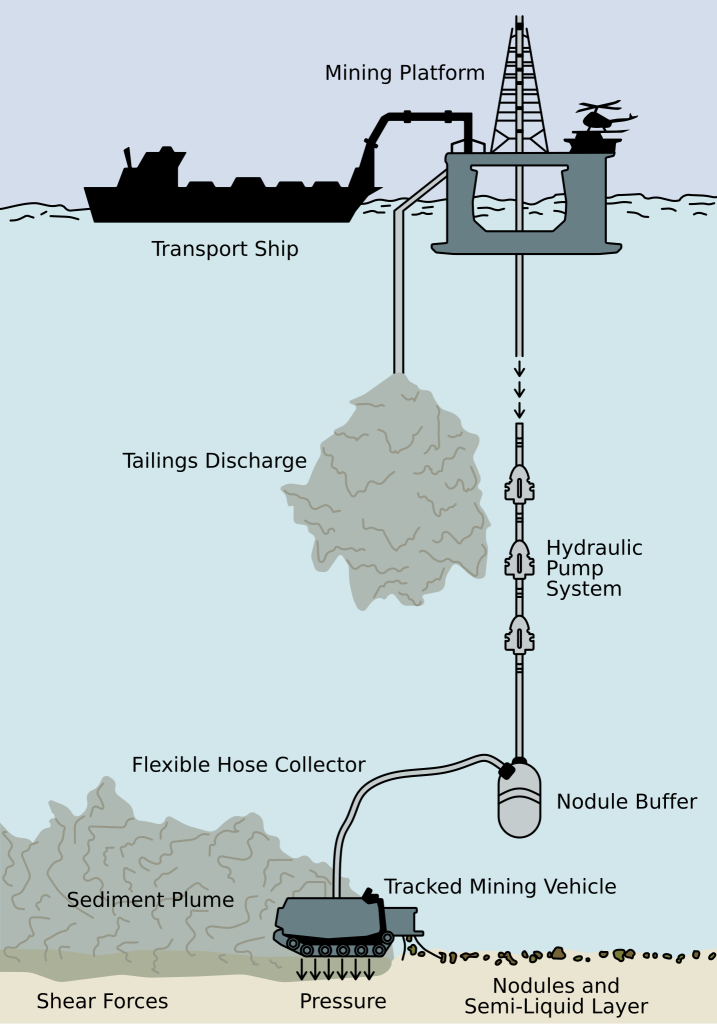Deep-sea mining is the next frontier. Do the economic and commercial benefits outweigh the environmental risks?
The ocean floor is filled with trillions of deposits of rare earth elements including lithium, cobalt, copper, nickel, aluminium, manganese and zinc. Engineers are devising ways to mine them at depths from 200-6000 m below the surface.
Commercial deep-sea mining is not expected to begin until 2026, with the International Seabed Authority (ISA), which regulates activities in the seabed beyond national jurisdictions, so far issuing 31 exploration permits to 22 contractors.
More than half are in the Clarion-Clipperton Zone between Mexico and Hawaii, which is estimated to possess six times more cobalt and three times more nickel than all known land-based stores. These are critical minerals for the lithium-ion batteries powering the green energy transformation.
Closer to home, the practice is largely off-limits so far in Australia. But Pacific nations such as the Cook Islands are exploring rich cobalt and manganese deposits in their waters. In total, the ISA has set aside more than 1.5 million km2 of international seabed for exploration – an area roughly the size of Mongolia.
Increasing demand for minerals to power everything from smart phones to wind turbines is leading exploration for minerals in these uncharted waters. While the bounties are rich and remove some of the barriers to terrestrial mining, this new frontier brings with it a whole new set of environmental and engineering challenges – and ethical questions.

How it works
There are three types of deep-sea minerals: polymetallic nodules, polymetallic sulphides and cobalt-rich ferromanganese crusts. The most readily available deposits are polymetallic nodules, potato-sized mineral rocks which sit on the ocean floor and do not need to be harvested by digging or drilling.
Nodule mining involves a surface-operation vessel which lowers a caterpillar-track collector vehicle kilometres under the ocean. Tethered to the vessel above, it removes the top 10-15 cm of the seabed in what’s called a collector plume. The vehicle then uses a hydraulic collector and a riser pipe system to bring the minerals to the surface vessel. One undersea caterpillar can store three tonnes of nodules.
The secondary plume is created by the discharge when returning unwanted sediment down a water column into the ocean.
The benefits
The need to decarbonise and embrace renewable energy means that the thirst for minerals to power green technology is greater than ever. With demand for electric vehicles alone expected to grow by around 30 times between 2020 and 2040, a report by the International Energy Agency found that we aren’t mining enough of the minerals required to power the clean energy future.
Proponents of deep-sea mining argue that the greatest threat to the ocean is global warming, so mining minerals that promote decarbonisation inherently protects it. On land, many of these critical minerals are confined to a handful of countries. Presently, 70 per cent of the world’s cobalt comes from the Democratic Republic of Congo (DRC), while Argentina, Australia, Chile and China hold 95 per cent of lithium stores.
Not only does this hand power disproportionately to a small number of nations, but it has the potential to cause significant supply chain issues. Deep-sea mining opens up potential wealth and job creation to a wider range of countries, particularly in the Pacific, where impoverished nations are already on the front lines of climate change.
As evidenced by human catastrophes caused by terrestrial mining for these minerals in places such as DRC and Chile, it has been argued that deep-sea mining is a better alternative, as it does not create harmful waste by-products or cause mass displacements of people and communities.
The drawbacks
So far, not only is little known about the short- and long-term effects of mining on deep-water ecosystems, but little is known about these ecosystems altogether.
One study that simulated deep-sea mining in the Peru Basin in 1989 found that the area, which is similar to the Clarion-Clipperton Zone, has yet to recover some 30 years later. Machine tracks can still be found in the seabed, while populations of some marine flora and fauna had yet to return, and “could potentially lead to an irreversible loss of some ecosystem functions”.
The extraction process generates dense plumes of sediment which could irreversibly affect the habitat. According to MIT researchers, sediment accumulates at a rate of one millimetre each millennium in the deep-ocean, and it is unlikely that areas disturbed by mining could recover on a reasonable timescale.
Marine life is also at risk from heating and poisoning of the water and sediment discharge, while the noise and light pollution expected to be generated in such a dark and silent environment may affect the feeding and reproduction of many species.
And, as with mining above the waves, effective regulation and governance of underwater mining remains a real concern, as well as the exploitation of poor nations and communities who are closest to reserves of mineral wealth.
